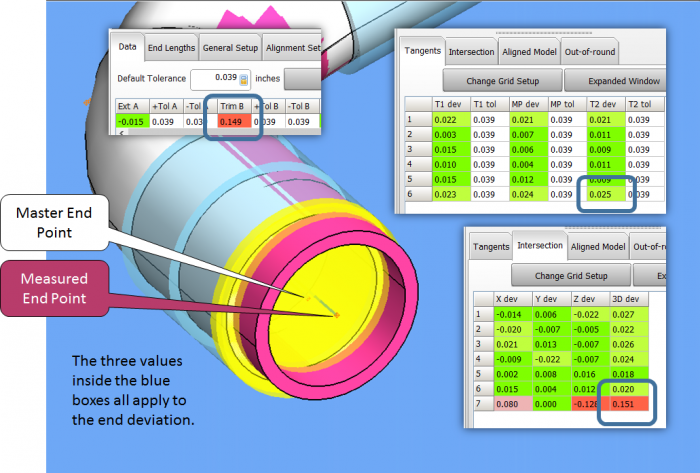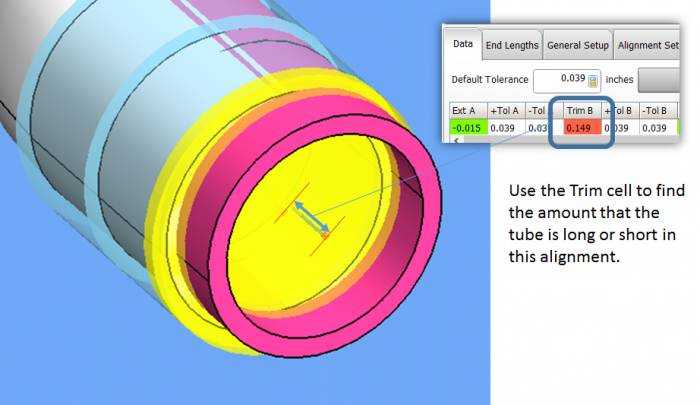|
|
| Line 58: |
Line 58: |
| | | | |
| | <br><br> | | <br><br> |
| − |
| |
| − | =Typical Industry Tangent Point Tolerances=
| |
| − | <table cellpadding=10>
| |
| − | <tr valign=top>
| |
| − | <td width=500>
| |
| − | In working with thousands of customers over the past few decades, we've seen some trends in accepted envelope deviation tolerances. Here are what we commonly see:
| |
| − |
| |
| − | ====Aerospace and Automative Fluid Lines====
| |
| − | <table cellpadding=10 width=400>
| |
| − | <tr>
| |
| − | <td bgcolor=#9999CC>
| |
| − | Diameter Range
| |
| − | </td>
| |
| − | <td bgcolor=#CCCCFF width=200>
| |
| − | Envelope Tolerance
| |
| − | </td>
| |
| − | </tr>
| |
| − |
| |
| − | <tr>
| |
| − | <td>
| |
| − | 12.7 mm (0.5 inch) diameter tubes or less
| |
| − | </td>
| |
| − | <td>
| |
| − | +/- 1 mm (0.039 inches)
| |
| − | </td>
| |
| − | </tr>
| |
| − |
| |
| − | <tr>
| |
| − | <td>
| |
| − | Greater than 12.7 mm (0.5 inch)
| |
| − | </td>
| |
| − | <td>
| |
| − | +/- 2 mm (0.078 inches)
| |
| − | </td>
| |
| − | </tr>
| |
| − |
| |
| − | </table>
| |
| − |
| |
| − | ====Automotive Exhaust Pipes====
| |
| − | <table cellpadding=10 width=400>
| |
| − | <tr>
| |
| − | <td bgcolor=#9999CC>
| |
| − | Diameter Range
| |
| − | </td>
| |
| − | <td bgcolor=#CCCCFF width=200>
| |
| − | Envelope Tolerance
| |
| − | </td>
| |
| − | </tr>
| |
| − |
| |
| − | <tr>
| |
| − | <td>
| |
| − | 50 mm to 76 mm
| |
| − | </td>
| |
| − | <td>
| |
| − | From +/- 2 mm to +/- 3 mm
| |
| − | </td>
| |
| − | </tr>
| |
| − |
| |
| − | <tr>
| |
| − | <td>
| |
| − | 76 mm to 102 mm
| |
| − | </td>
| |
| − | <td>
| |
| − | +/- 3 mm
| |
| − | </td>
| |
| − | </tr>
| |
| − |
| |
| − | <tr>
| |
| − | <td>
| |
| − | Larger then 102 mm
| |
| − | </td>
| |
| − | <td>
| |
| − | +/- 3 mm or greater
| |
| − | </td>
| |
| − | </tr>
| |
| − |
| |
| − | </table>
| |
| − |
| |
| − | ====Shipbuilding====
| |
| − | <table cellpadding=10 width=400>
| |
| − | <tr>
| |
| − | <td bgcolor=#9999CC>
| |
| − | Diameter Range
| |
| − | </td>
| |
| − | <td bgcolor=#CCCCFF width=200>
| |
| − | Envelope Tolerance
| |
| − | </td>
| |
| − | </tr>
| |
| − |
| |
| − | <tr>
| |
| − | <td>
| |
| − | All Diameters
| |
| − | </td>
| |
| − | <td>
| |
| − | +/- 6 mm
| |
| − | </td>
| |
| − | </tr>
| |
| − |
| |
| − | </table>
| |
| − |
| |
| − |
| |
| − | ====HVAC====
| |
| − | <table cellpadding=10 width=400>
| |
| − | <tr>
| |
| − | <td bgcolor=#9999CC>
| |
| − | Diameter Range
| |
| − | </td>
| |
| − | <td bgcolor=#CCCCFF width=200>
| |
| − | Envelope Tolerance
| |
| − | </td>
| |
| − | </tr>
| |
| − |
| |
| − | <tr>
| |
| − | <td>
| |
| − | All Diameters
| |
| − | </td>
| |
| − | <td>
| |
| − | +/- 2 to +/- 3 mm
| |
| − | </td>
| |
| − | </tr>
| |
| − |
| |
| − | </table>
| |
| − |
| |
| − | ====Structural Tubes (Frames)====
| |
| − | <table cellpadding=10 width=400>
| |
| − | <tr>
| |
| − | <td bgcolor=#9999CC>
| |
| − | Diameter Range
| |
| − | </td>
| |
| − | <td bgcolor=#CCCCFF width=200>
| |
| − | Envelope Tolerance
| |
| − | </td>
| |
| − | </tr>
| |
| − |
| |
| − | <tr>
| |
| − | <td>
| |
| − | All Diameters
| |
| − | </td>
| |
| − | <td>
| |
| − | +/- 2 to +/- 3 mm
| |
| − | </td>
| |
| − | </tr>
| |
| − |
| |
| − | </table>
| |
| − |
| |
| − | ====Tighter Tolerances====
| |
| − |
| |
| − | Sometimes customers will required +/-0.75 mm - but this is very rare. We've never seen tube shapes that must be qualified with a deviation tolerance of less than +/- 0.75 mm.
| |
| − |
| |
| − | </td>
| |
| − | <td width=300>
| |
| − | [[image:aerospace_envelope_tolerance.png|400px]]<br>
| |
| − | [[image:exhaust_envelope_tolerance.png|400px]]<br>
| |
| − | [[image:shipbuilding_envelope_tolerance.png|400px]]<br>
| |
| − | </td>
| |
| − | </tr>
| |
| − | </table>
| |
| | | | |
| | =Other Pages= | | =Other Pages= |




